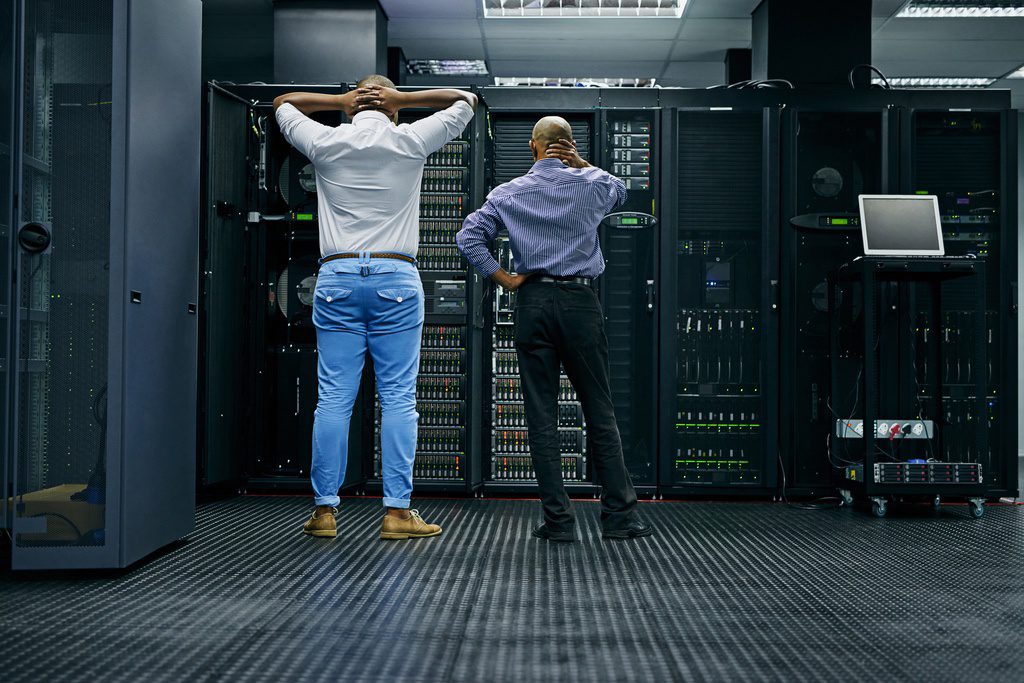Key Points
- IT problems can be particularly hard on the many businesses that have embraced hybrid or remote work since the start of the COVID-19 pandemic.
- Many of these problems—like compatibility issues and security gaps—are due to outdated technologies that aren’t designed to work well together, although some can result from human error via poor communication or a lack of proper training.
- Unifying your IT environment so that critical applications and equipment are able to share information seamlessly will eliminate many of these problems, as will workplace training for your employees.
- Embracing audiovisual solutions designed specifically for your space, team, and communication goals will also be vital if your business uses a hybrid workplace or has any remote employees. ET Group’s HybridX solution can help you create a dynamic hybrid workplace with a human-centric focus and reduce or eliminate IT challenges for your people.
Many businesses find managing IT infrastructure challenging—and with hybrid and remote work on the rise since the start of the COVID-19 pandemic, IT issues have the ability to impact your operations more severely than ever. From compatibility problems across different services to team members who may not all be on the same page about how to use your setup, there are many IT problems that can plague you unless you approach them proactively.
As leading providers of hybrid workplace solutions, we’ve seen IT work environments of every kind up close and are extremely familiar with the problems most of them need to solve. Below, we’ll walk you through 7 of the most common and provide insights on how to solve them so you can start improving the technology your business relies on today.

Via Adobe Stock.
Poor Communication
The Snag
This might seem like an HR issue instead of an IT problem at first—but trust us, it’s usually both. When people talk about using “the right tools” to communicate, they don’t always mean it as a metaphor; sometimes you literally need the right tools. This could look like outdated video conferencing technology, or perhaps an inadequate project management platform—the bottom line is, it doesn’t matter how good your team’s interpersonal skills are if they’re held back by obsolete IT.
The Solve
Good technology isn’t byzantine or obtrusive—when it’s designed and implemented properly, your team should barely know it’s there. Using IT equipment with human-centric space designs prevents your people from getting frustrated, improving their ability to give each other accurate information and solve problems together.
Compatibility Problems
The Snag
Software and hardware from competing brands generally doesn’t play nicely together without some specific coaxing (for example, some users experience issues attempting to join Microsoft Teams calls that have been created with Google Calendar).
The Solve
Using communication tools designed to talk with each other facilitates smoother transitions when exchanging data between different applications. Consider moving to a single-point solution designed to integrate your meeting platforms and communication software.
Security Threats
The Snag
“Piecemeal” IT environments cobbled together by adding individual applications or pieces of hardware over years often have gaping security holes that can be exploited by threat actors. For example, a business that’s recently started using cloud-based applications like Dropbox or Google Drive to store and share internal documents might not have a cloud access security broker (CASB) to enforce access control policies, allowing employees to use weak and easily-compromised passwords for their accounts.
The Solve
Investing in professional IT support can help you identify and plug gaps in your security posture. For example, you can learn about vulnerabilities that exist in your audiovisual setup by downloading our service and support package.

Via Adobe Stock.
Lack of Training
The Snag
How often have you heard a coworker complain about technical issues when trying to deliver a presentation or host a meeting? Sometimes, technology isn’t the problem in these cases—it could be that your people don’t have the proper training to use it effectively.
Typically, If an IT problem can be solved by improving training or providing additional guidance to users, it’s likely a training issue—but if the problem persists despite training efforts, it’s likely a technology issue that needs to be addressed by IT professionals. Another tell is that some employees are struggling but others aren’t—for example, if some of your employees are comfortable with your new videoconferencing software but others are struggling to join meetings, the problem likely isn’t with the software itself.
The Solve
Teaching your people how to thrive in your IT environment is just as important as the technology it uses. Consider workshops that equip your team for hybrid environments by identifying practices that aren’t working and explore opportunities to improve them.

Via Adobe Stock.
Remote Work Challenges
The Snag
While remote work has become increasingly normalized since the start of the COVID-19 pandemic, many businesses are still struggling to adapt to its challenges. A lack of face-to-face communication in your organization’s IT environment, or poorly set-up conferencing technology that makes meeting attendees feel strained or tired (i.e. “Zoom fatigue”) can contribute to social isolation that has negative impacts on your organization’s productivity and the mental health of your team.
The Solve
There are actually a few things you can do to overcome these issues. Audiovisual solutions that simplify your ability to hold video meetings are an excellent way to combat the isolation that can come with remote work. Research suggests that the closer your video conferencing technology comes to recreating a face-to-face environment, the less stress and fatigue it causes for attendees.
It’s also worth spending some time and resources to discover exactly what challenges your team is having with remote work. Consider taking the time to engage a consultant who can audit your IT environment and find the most efficient ways to address your team’s pain points.
Limited Access to Information
The Snag
The more complex your IT environment is, the less likely all your organization’s members will be to use every feature or service. This can eventually lead to miscommunication (like someone neglecting to sign a time-sensitive document because it was stored on a cloud-based file sharing platform they hate using instead of being emailed to them).
The Solve
Creating an IT environment where your key applications are set up to share data doesn’t just help solve compatibility issues for your software and hardware—it also reduces the likelihood of human error when important information is being shared or tasks are being assigned. Learn more about the benefits of setting up your IT infrastructure to focus on user experience.

Via Adobe Stock.
Inadequate Disaster Recovery
The Snag
Many organizations have inadequate disaster recovery plans, which can leave them vulnerable to data loss and system downtime. Often, this is due to the fact that these plans are not updated as the organization’s IT environment grows and changes over time, leaving gaps in the security posture that can be exploited.
The Solve
Invest in a solution to bring your IT equipment onto the same page. Our HybridX solution includes backup and recovery software to help you retain system configurations and other critical data for your audiovisual technology, helping you maintain business continuity even in the event of a disaster.
Unified IT Environments Remove Friction and Improve Outcomes
When your IT environment is updated so that critical applications and systems can communicate without errors or delays, you create a more secure, user-friendly, and productive workplace. This is especially important for the many organizations that have adapted to the challenges brought on by COVID-19 by embracing hybrid work environments and remote work.
Creating an optimal hybrid environment requires best-in-class data protection, technical support, and audiovisual solutions. Contact us to learn more about how the HybridX can provide solutions to many of the challenges outlined above by removing friction for users and streamlining the way your people connect.
Stay connected with us:
Follow ET Group on LinkedIn
Follow us on Twitter
Subscribe to ET Group’s YouTube Channel








